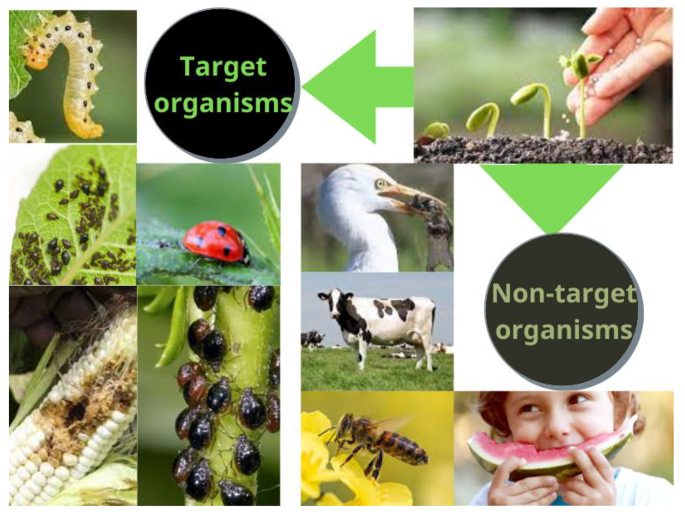The smart Trick of Eco Bed Bug Exterminators Dc That Nobody is Talking About
The smart Trick of Eco Bed Bug Exterminators Dc That Nobody is Talking About
Blog Article
What Does Eco Bed Bug Exterminators Dc Do?
Table of ContentsThe Basic Principles Of Eco Bed Bug Exterminators Dc Eco Bed Bug Exterminators Dc Fundamentals ExplainedOur Eco Bed Bug Exterminators Dc IdeasThe Basic Principles Of Eco Bed Bug Exterminators Dc What Does Eco Bed Bug Exterminators Dc Mean?
Because chemicals are toxic, they are also possibly harmful to humans, pets, various other microorganisms, and the environment. Therefore, individuals that utilize pesticides or on a regular basis can be found in call with them need to recognize the relative toxicity, possible health and wellness results, and preventative measures to decrease direct exposure to the products they utilize. Risk, or risk, of using pesticides is the potential for injury, or the level of danger entailed in making use of a chemical under a provided collection of conditions.
Applicators can reduce or almost get rid of exposure-- and hence reduce hazard-- by following the tag instructions, using personal safety apparel and devices (PPE), and handling the pesticide appropriately. As an example, more than 95 percent of all chemical direct exposures come from facial direct exposure, mainly to the hands and forearms. By putting on a set of unlined, chemical-resistant handwear covers, this kind of exposure can be virtually gotten rid of.
The harmful results that occur from a single direct exposure by any kind of route of entrance are termed "intense results." The four courses of exposure are facial (skin), breathing (lungs), dental (mouth), and the eyes. Severe toxicity is figured out by examining the facial poisoning, breathing toxicity, and dental toxicity of guinea pig.
The Buzz on Eco Bed Bug Exterminators Dc
Intense poisoning is determined as the amount or focus of a toxicant-- the a.i.-- needed to eliminate 50 percent of the animals in a test populace. This procedure is generally revealed as the LD50 (deadly dosage 50) or the LC50 (deadly concentration 50). In addition, the LD50 and LC50 worths are based on a single dose and are recorded in milligrams of chemical per kilogram of body weight (mg/kg) of the test pet or partially per million (ppm).
The reduced the LD50 or LC50 worth of a chemical item, the higher its poisoning to humans and pets. Pesticides with a high LD50 are the least toxic to people if utilized according to the instructions on the product tag. The chronic toxicity of a chemical is determined by subjecting examination animals to long-term direct exposure to the active component.
The chronic poisoning of a pesticide is a lot more tough than intense poisoning to identify through lab analysis. Products are classified on the basis of their family member severe toxicity (their LD50 or LC50 values). Pesticides that are identified as highly harmful (Toxicity Category I) on the basis of either dental, dermal, or inhalation toxicity should have the signal words DANGER and toxin published in red with a head and crossbones icon prominently presented on the front panel of the package label.
The severe (solitary dosage) dental LD50 for pesticide products in this group varies from a trace total up to 50 mg/kg. Exposure of a few drops of a product taken by mouth could be fatal to a 150-pound individual. https://slides.com/ecobedbug3xt. Some chemical items have simply the signal word threat, which tells you nothing regarding the acute poisoning, simply that the product can trigger serious eye damages or severe skin inflammation
The Best Guide To Eco Bed Bug Exterminators Dc
In this classification, the acute oral LD50 varieties from 50 to 500 mg/kg. A tsp to an ounce of this product could be deadly to a 150-pound individual (bed bug heater rentals). Chemical items categorized as either slightly poisonous or reasonably harmless (Toxicity Classifications III and IV) are needed to have the signal word care on the pesticide label

All pesticide toxicity chemical, including the Consisting of, can be found on the product's Item Safety Product Security InformationMSDS). Chemical tags and MSDS can be acquired from stores or produces - https://ecobedbug3xt.start.page. The signs and symptoms of chemical poisoning can range from a light skin inflammation to coma or also fatality.
Due to the fact that of potential health worries, pesticide individuals and handlers need to identify the typical indications and signs and symptoms of pesticide poisoning. The impacts, or signs, of pesticide poisoning can be click to read generally specified as either topical or systemic.
Some Ideas on Eco Bed Bug Exterminators Dc You Need To Know
Dermatitis, or inflammation of the skin, is accepted as the most frequently reported topical effect connected with pesticide direct exposure. Some individuals often tend to cough, hiss, or sneeze when exposed to chemical sprays.
This signs and symptom normally subsides within a couple of minutes after a person is eliminated from the direct exposure to the irritant. However, a response to a chemical item that creates someone not only to sneeze and cough but additionally to create severe intense breathing signs and symptoms is a lot more likely to be a true hypersensitivity or sensitive reaction.
Systemic impacts are quite different from topical impacts. They commonly occur away from the initial factor of get in touch with as an outcome of the chemical being soaked up right into and dispersed throughout the body. Systemic impacts commonly consist of nausea or vomiting, vomiting, exhaustion, frustration, and digestive tract disorders. In sophisticated poisoning cases, the individual might experience modifications in heart rate, difficulty breathing, convulsions, and coma, which could bring about fatality.
Report this page